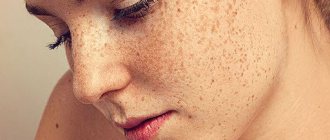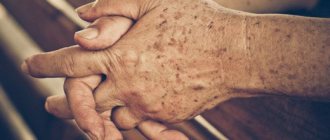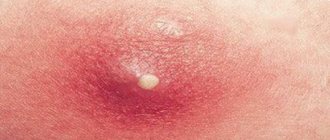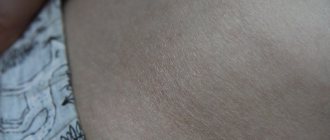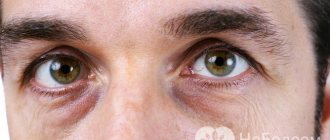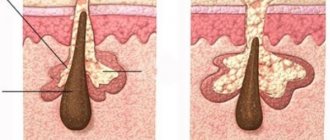Causes
The spot on the leg may be a mole or freckle. Increased pigmentation of the lower extremities is the result of melanin accumulation. And if it appears under the influence of ultraviolet radiation, then this is perhaps the safest cause of hyperpigmentation of the legs.
Dark spots can also appear as a result of ruptured capillaries. In this case, the area is small and does not require therapeutic measures. In other cases, the causes of pigmentation on the legs or groin lie in one or another pathology. Below is a list of diseases that can cause skin pigmentation on the legs.
- Vascular lesions as a result of diabetes, atherosclerosis and varicose veins.
- Neurofibromatosis. This is the name given to numerous inclusions of a milky-brown hue. They appear for genetic reasons.
- Chronic dermatitis. It is caused by wearing tight clothing, allergies to cosmetic products, fabrics. Stasis dermatitis develops as a result of varicose veins of the deep veins. Areas of darkening on the skin itch, become rough, and become rough.
- Dark areas may appear due to cirrhosis or fibrosis of the liver tissue.
- A dark spot on the skin may be a sign of developing carcinoma. Melanomas on the sole are especially dangerous.
- Some pathologies of the cardiac and vascular system can cause brown spots on the skin of the legs.
- The skin also darkens with vitamin deficiency - a lack of B vitamins.
- If redness appears in the area of the little finger or thumb, then this is the first sign of the development of psoriasis. With this disease, pink or reddish pigmentation appears on the feet and ankles.
Age spots on women's legs
Some women may experience brown spots on their legs while pregnant. The cause of pigmentation on the legs is hormonal changes. After childbirth, skin color returns to normal.
Interesting! Only women may experience characteristic skin changes in the form of chloasma. This is focal hyperpigmentation of the skin. There is no treatment for chloasma: all cosmetic measures are limited to reducing the intensity of skin coloring.
Age spots on the legs of men
Pigmentation on the legs in men can develop as a result of Becker's melanosis . It looks like a mole and develops most often in teenagers. In an area of increased pigmentation, increased hair growth may be observed. The cause of Becker's melanosis has not yet been clearly established. If varicose veins are left untreated, pigmentation of the legs below the knee appears in the form of pink and then red spots. In severe cases, their color changes and they become purple, almost black.
Note! The appearance of black spots indicates that a necrotic process is developing in the skin. Without emergency treatment measures (surgery), gangrene may develop.
Pigmentation of legs with varicose veins
Varicose veins spots appear if the disease has reached an advanced stage. Untimely treatment of the pathology leads to the fact that the veins become clogged with blood clots. Because of this, oxygen metabolism in the tissues is disrupted and they experience oxygen starvation. This is one of the reasons for increased pigmentation of the skin on the legs.
Important! Skin pigmentation on the lower leg and other parts of the limbs does not appear in one day. The skin turns red because blood stagnates in the legs. If varicose veins are left untreated, the skin turns brown. When trophism is disrupted, the skin becomes covered with dark areas.
Predisposing factors
- wearing tight shoes;
- constant microtrauma of the skin of the legs;
- hyperhidrosis;
- use of low-quality household chemicals.
Causes of hyperpigmentation
Acquired changes in skin color occur under the influence of various factors, such as diseases of the thyroid gland - hyperthyroidism and toxic goiter, pathologies of the liver and gall bladder - viral and toxic hepatitis, obstructive jaundice, dermatological diseases, namely mycoses, insufficient amounts of vitamins or minerals, disruption of processes metabolism, excess vitamin A.
The cause of changes in skin color may be the presence of endocrine pathologies, for example, hypercoriticism and tumor processes, an example is the presence of neurofibromatosis.
The progression of certain diseases of the gastrointestinal tract can lead to changes in skin color.
In addition, they cause hyperpigmentation:
- Ischemic processes that occur with varicose veins, thrombosis and thrombophlebitis.
- Benign and malignant skin tumors - nevi, melanoma, squamous cell carcinoma.
- Inflammatory processes after injury and surgery.
Changes in skin color occur due to poor diet, lack of physical activity, excessive stress and fatigue.
Skin care procedures also affect the condition of the skin - incorrectly selected cosmetics can lead to inflammation and pigmentation.
The appearance of pigment accumulations can be caused by taking certain medications, such as tetracycline, salicylic acid, St. John's wort, and excessive consumption of brightly colored foods.
Types of spots on legs
There are three types of pigmented areas on the legs.
- Leucoderma . It is characterized by decreased pigmentation of the lower extremities, and the skin on the affected areas appears much lighter.
- Melasma . Darkening of the skin is characteristic.
- Blue-gray pigmentation.
These types of disorders are not independent types of pathologies. They indicate that some pathological process is occurring in the body.
Anti-pigmentation cream on the face: which is better, and how to choose the right product
Types of stains:
- mesh;
- marble;
- spotted;
- leprosy;
- lichen;
- keratoses;
- lentigo (age spots);
- post-inflammatory pigmentation;
- warts;
- moles;
- comedones (or the so-called strawberry legs effect);
- venous stasis (in which the skin becomes dark and even purple over a large area of the leg);
- diabetic spots;
- chronic pigmentary purpura;
- petechiae, or marble hemorrhages;
- Kaposi's sarcoma (caused by herpes virus type eight).
What are pigment spots on the legs?
The pigment melanin is responsible for the appearance of brown spots, in particular, its excess or deficiency. When, due to some provoking factors, the production of such pigment inside melanocyte cells is disrupted, then similar cosmetic defects of a dark or light shade are formed on certain parts of the skin. This pathological process is called hyperpigmentation.
When red-brown spots are observed on the lower extremities, this indicates a violation in the integrity of the blood vessels. In such a situation, small capillaries may rupture, unable to hold the entire volume of blood.
This also causes the formation of a large red spot on the surface of the leg. This phenomenon is observed in overweight patients or in patients who, due to the nature of their work activities, are forced to remain in a standing position for a long time.
Such formations, mainly, are not able to go away on their own and are not only a cosmetic defect, but can also cause the formation of a hematoma under the skin - an unsafe condition leading to a failure of normal blood circulation.
Treatment of age spots on legs
Many patients are interested in how to remove pigmentation on their legs. This can only be done after its cause has been established. Self-medication of discolored legs is dangerous and can cause burns. First of all, you need to contact a dermatologist, phlebologist, or endocrinologist. Women should definitely visit a gynecologist. The causes and treatment of pigmentation on the legs are closely related, and doctors will prescribe a comprehensive examination. After this, it will be possible to select the most effective treatment.
Treatment for hyperpigmentation consists of:
- getting rid of the underlying pathology;
- strengthening the immune system;
- taking antihistamines (most often in the form of an ointment);
- sclerotherapy.
Hyperpigmentation can be removed:
- chemical types of peeling;
- laser;
- whitening creams.
Medicinal treatments
There are medical ways to get rid of hyperpigmentation on the legs. They are selected by the doctor depending on the cause of their occurrence.
- If the cause of the spots is age-related changes, anti-aging drugs with vitamins A and antioxidants are prescribed.
- For fungal pathologies, ointments and creams with a fungicidal effect should be used.
- If a mole has formed, it does not need to be touched. Removal of a nevus occurs only according to a doctor’s indications.
- For age spots on the legs, vitamin complexes with minerals are used.
- If the cause of the spots is varicose veins, take tablets and ointments to strengthen the veins.
- If you have diabetes, you should take antihyperglycemic drugs or insulin (Related: What can you eat if you have diabetes?).
- It is useful to take immunomodulators.
What is the danger of age spots?
SAMSUNG
Usually, the danger of pigmentary skin disorders is often underestimated. It should be noted:
- If spots appear on the legs against the background of pain in the abdominal or lumbar cavity, weakness, yellowing of the sclera, change in the color of urine, you should immediately consult a doctor due to possible damage to the kidneys or liver.
- In the event of excessive pigmentation without visible manifestations of pathology of other organs and systems, you should pay attention to your own wardrobe; the likely cause may be the presence of uncomfortable clothing that has caused poor circulation. Here it is recommended to engage in active sports activities in the form of jogging. If there is no positive effect after this, you should check the condition of your cardiovascular system.
- Foot localization against the background of hyperhidrosis indicates the presence of foot hyperhidrosis, which is a disorder of the autonomic nervous system. You should consult a doctor and carry out appropriate diagnostic tests.
Spots and dots on the legs with varicose veins: what is it, treatment of vascular pigmentation
Varicose veins, in addition to stars, leave marks on the skin: spots on the legs can be of very different colors and configurations. In the early stages they are not accompanied by pain, but as the pathology progresses, pain and serious trophic changes occur.
- What not to do
- Microbial eczema . Due to varicose veins, the barrier function of the skin is reduced and it is more difficult for the body to fight back pathogens. Under the influence of such a continuous “bombardment”, microbial eczema starts. The source of inflammation is clearly defined red spots, the skin flakes and itches. Redness of the lower leg occurs more often.
- Lipodermatosclerosis , which is caused by impaired blood circulation in the dermis. With chronic venous insufficiency, the pressure in the lumens of blood vessels increases. As a result, the blood plasma leaves the channel and moves into the subcutaneous tissue. The protein contained in it, under the influence of tissue enzymes, changes and is perceived by the body as a foreign substance. This is how the inflammatory process and accompanying signs begin: red spot, itching, peeling, erosion, purulent formations.
- White skin atrophy . Pathological changes in the veins lead to atrophy of adjacent skin areas. There is no inflammatory process as such, but irregularly shaped scars form on the skin, outlined by rims of hyperpigmented skin.
Why do they appear?
The formation of pigmentation begins with the fact that the valves of the vessels that allow blood to pass upward work intermittently. The blood flow becomes chaotic, and in places where the valves do not work, stagnation occurs and pigment spots form on the skin. Malnutrition of soft tissues causes redness.
The red spots darken, thicken and itch. At the next stage, the spots are already brown, liquid oozes through them, most often they are localized in the ankle area. If the moment is missed, adequate treatment is not applied, at the fourth stage trophic ulcers are formed, often complicated by infections.
With advanced varicose veins, complications arise:
Untimely or incorrect treatment leads to thrombosis of blood vessels and oxygen deficiency in tissues, resulting in the formation of blue spots on the skin. Bruises appear that do not go away for a long time. Blue spots indicate that the disease has become chronic. In some areas they are almost purple.
Blue spots and their gradual blackening are an alarming symptom of the transition of varicose veins to the final stage. If the leg is already turning black, the question of surgical intervention may be raised.
How to remove
Bruises, red, brown and black spots on the lower limbs can only be eliminated with correct and continuous treatment. Upon successful completion of a course of conservative therapy, additional consultation with a vascular surgeon and dermatologist will be required.
All “traces” of varicose veins, including extensive ones in the form of a bruise, can be removed using a medical laser. The operation will be preceded by a long process of normalizing blood circulation. To do this, the attending physician will draw up an individual course of therapy:
Drugs
Drug therapy is of particular importance in the early stages of the disease. Properly selected medications, the action of which is aimed at strengthening and increasing the elasticity of the venous walls, will help stop the progress of the disease and eliminate spots from the skin of the legs.
As part of complex treatment, the following are prescribed:
- Anticoagulants . Prevents the formation of blood clots. Among them: Clexane, Fraxiparine.
- Antioxidants . Among them: vitamin E, Ginkort-fort.
- Disaggregants . Increase blood fluidity and reduce the risk of blood clots. Among them: Aspirin, Doxium, Vasobral.
- Fibrinolytics . They destroy formed blood clots and are prescribed only in combination with other drugs for varicose veins. Among them: Avelizin brown, Thromboflux.
- Phlebotonics . They normalize the outflow of venous blood in the lower extremities and reduce excess pressure on the vessels. Among them: Anavenol, Venarus, Venoruton.
Minimally invasive interventions
Effective mainly in the early stages of varicose veins. Depending on the characteristics of the disease, the following methods are recommended:
- Sclerotherapy . Excludes the affected vein from the circulatory system. Using a very thin needle, a sclerosant drug is injected into the vein. The active substance blocks the blood flow and the walls of the vessel stick together.
- Endovenous laser coagulation . One of the safest methods of surgical treatment. The vessel is punctured with a needle, and under ultrasound control, a laser light guide is led into the lumen of the saphenous vein. Under the influence of the laser, the affected area of the vein stops working and sticks together.
- Radiofrequency ablation . A disposable catheter is used, which is inserted into the vein through a very thin puncture. A radiofrequency pulse acts on the affected vessel wall, causing the vein to close. Blood flow in the area is restored.
- Miniphlebectomy . A small incision or puncture is made over the affected area and, using a special hook, the varicose vein is brought to the surface and removed.
Surgical intervention
It is possible to normalize blood flow in deep veins (with a diameter above 15 millimeters and with great tortuosity) with advanced venous insufficiency using a classic operation - phlebectomy.
https://www.youtube.com/watch?v=xaf1PIxCGBk
Under local anesthesia (rarely, therapeutic sleep), a small incision is made in the groin or lower leg and a probe is inserted. The main trunk of the affected vein with all its ducts is removed and cosmetic sutures are applied.
Diet
Attention! The main rule when creating a daily menu for patients with varicose veins is to avoid exceeding the calorie limit and maintain a healthy weight.
With obesity, there is an excessive load on the veins, and with a deficiency, the process of hematopoiesis and the normal functioning of the entire cardiovascular system are disrupted.
You need to focus on foods rich in vitamins:
- C – ensures the production of collagen and normalizes blood circulation,
- E – maintains veins in tone and promotes their cleansing,
- group B – strengthens the walls of blood vessels,
- K - strengthens capillaries and ensures normal blood clotting.
To this end, the diet should include:
- Broccoli.
- Brussels sprouts.
- Spinach.
- Parsley.
- Tomatoes.
- Lemons.
- Oranges.
- Kiwi.
- Brown rice
- Barley.
- Wheat (bulgur).
It is important to maintain water balance - drink the amount of water recommended for a certain age and taking into account the characteristics of the body (from 1.5 to 2.5 liters per day).
Physiotherapy
A number of physiotherapeutic methods can eliminate aesthetic defects on the skin and generally slow down the progression of varicose veins.
- Ozone therapy – to improve blood circulation. The advantage of the procedure is that it is easy to perform and painless. Minus - it is contraindicated for hyperthyroidism, hypotension, hypoglycemia, diabetes mellitus and a number of other diseases.
- Pressotherapy – to restore elasticity and reduce the permeability of vascular walls.
- Myostimulation – to activate muscle function and normalize blood circulation.
Self-massage is effective for varicose veins, but vacuum massage and LPG are contraindicated. Some experts are of the opinion that LPG massage in a gentle mode can be performed in the early stages of the disease and for the purpose of prevention.
Exercises
Moderate physical activity for varicose veins should be provided constantly. You can select and master special complexes of therapeutic gymnastics in exercise therapy rooms, and then practice independently at home.
the task is to activate the blood circulation process and prevent stagnation of fluids in the lower extremities. To do this, you need to warm up not only the leg muscles, but also all other parts of the body. If you have varicose veins, exercise in a sitting position and with your limbs down (for example, flexion and extension of the torso) should be avoided.
It is important to avoid overload: running, squats and stretches at an active pace, jumping and power presses, any endurance exercises. Swimming and walking are shown.
Compression jersey
The attending physician will select special medical knitwear that provides the desired degree of compression. It is prescribed to facilitate the outflow of blood, reduce the diameter and fix the affected veins.
In the early stages of the disease, wearing compression hosiery can eliminate heaviness and swelling; at any stage, it can prevent the spread of spots on the skin and the aggravation of other aesthetic defects.
Folk recipes
In the fight against cosmetic skin defects with varicose veins, herbal remedies have proven their effectiveness. As part of complex therapy (required after examination and consultation with the attending physician), the following is used:
- Honey compresses.
- Wormwood mixed with curdled milk.
- Celandine.
- Birch leaves.
- Aloe.
It is advisable to use medicinal herbs and other traditional medicine in the early stages of varicose veins.
What not to do
After removing stains from the skin, you will additionally need to use a care product selected by a specialist and protect the skin from exposure to direct sunlight.
To prevent spots on the legs, you should review your lifestyle for the presence of bad habits, which are usually not given serious importance:
- Incorrect postures while sitting . Body positions that are detrimental to veins are when one leg is tucked under oneself or thrown one over the other. You need to sit with a straight spine and keeping your legs at right angles to the floor.
- Excessive stress on the legs . When you have to walk or stand too much. If this is related to work, at the first opportunity you need to take breaks to rest - move around, do a simple warm-up and then sit, relaxing all your muscles.
- Clothes and shoes do not fit . A correctly selected pair does not squeeze the feet or rub the heels even when worn for the first time. The same goes for trousers and jeans - if the clothes fit correctly, even skinny models do not squeeze the leg muscles and do not tighten the abdominal area when sitting.
If you spend the day actively and do stretching exercises, your muscles have the opportunity to both work and relax. And movement is the main key to the prevention and development of varicose veins.
See inaccuracies, incomplete or incorrect information? Do you know how to make an article better?
Would you like to suggest photos on the topic for publication?
Please help us make the site better!
Source: https://kazandoctor.ru/bolezni/pochemu-poyavlyayutsya-i-kak-ubrat-temnye-venoznye-pyatna-na-nogah-pri-varikoze
Modern methods of getting rid of varicose veins
You can get rid of the hated age spots on your legs when the cause of the pathological process is determined.
Do not experiment on yourself by trying recipes from the Internet or dubious folk methods. Hyperpigmentation, as a sign of the disease, cannot be removed with iodine, hydrogen peroxide, or other drugs from the pharmacy. More likely - a burn, the appearance of a wound, a bubble.
If areas with suspicious pigmentation appear, you should contact a dermatologist, endocrinologist, phlebologist, gastroenterologist, or for women, a gynecologist and undergo a comprehensive examination. If a dermatologist suspects a malignant nature of the formation, he will refer you for a consultation with an oncologist.
Treatment goals for extremity hyperpigmentation:
- therapy of the underlying disease;
- strengthening the immune status of the body;
- use of antihistamine ointments, drugs;
- When venous strands appear in varicose veins, sclerotherapy is a gentle treatment method. A special drug is injected into the affected area, which glues the walls of the vessel. The technique allows you to remove a section of the vein without surgical intervention.
An important condition for getting rid of stains is making the correct diagnosis. Using homemade recipes, you are delaying time and aggravating your own condition.
If such spots appear in a child, and especially in an infant, you should immediately contact a medical facility.
In order to get rid of brown spots with varicose veins, you must first eliminate the cause of their appearance - a violation of tissue trophism. To do this, you will most likely have to take a blood test (general and biochemical), as well as undergo a duplex angioscan. The doctor will determine the cause of venous stagnation, assess the condition and patency of the vessels, and based on this, he will be able to prescribe effective treatment.
Even ancient doctors (Hippocrates, Paracelsus, Galen) tried to cure varicose veins. For many years, doctors have been looking for ways to combat this disease. Now doctors recommend modern methods of treating varicose veins, which help improve the patient’s condition.
Modern methods of treating varicose veins
Each generation of doctors tried to apply more and more new methods of treatment. Some doctors prefer surgical intervention, some prefer medication. Recently, specialists are increasingly using new treatment methods that are more effective and efficient than traditional ones. These ways to combat the disease include:
- Sclerotherapy.
- Laser treatment.
- Radiofrequency ablation of veins of the lower limb.
- Microphlebectomy.
Sclerotherapy procedure
There are various ways to get rid of varicose veins. And one of them is the method of compression phlebosclerosis.
This method has worked well for a long time. It is based on the use of drugs that, when injected into a vein, “glue” it from the inside due to the interaction of the components of the drug with the vascular wall.
As a result of this, the vein is switched off from the blood flow, since the movement of blood through it completely stops. The drugs used in sclerotherapy are highly effective and have a low degree of toxicity.
The sclerotherapy procedure takes 30 to 40 minutes. The doctor performs several injections of a sclerosing agent into the varicose vein. The number of procedures performed is determined individually. In some cases, more than 3 procedures are required, and the time interval between them must be at least a week.
Immediately after sclerotherapy, it is recommended to walk for about 30 minutes. An elastic bandage is applied to the leg, which is removed no earlier than 7 days after the procedure.
To carry out hygiene measures, the bandage can be removed, gently wash the leg in the shower, after which it should be blotted with a towel, apply a nourishing cream and bandage again with an elastic bandage.
Before coming to the next sclerotherapy session, the bandage must be removed 1.5 hours before.
Considering that wearing bandages is required for some time after this procedure, there are some nuances during the rehabilitation period. Firstly, during this time you should choose the most spacious shoes and clothing possible so that your feet are comfortable. Secondly, it is advisable to carry out sclerotherapy in the cold season, since wearing elastic bandages in the heat can be uncomfortable.
There are also medical restrictions that need to be taken into account during this period. In particular, for 2 months after sclerotherapy, you must avoid visiting the sauna, bathhouse, and taking hot baths.
